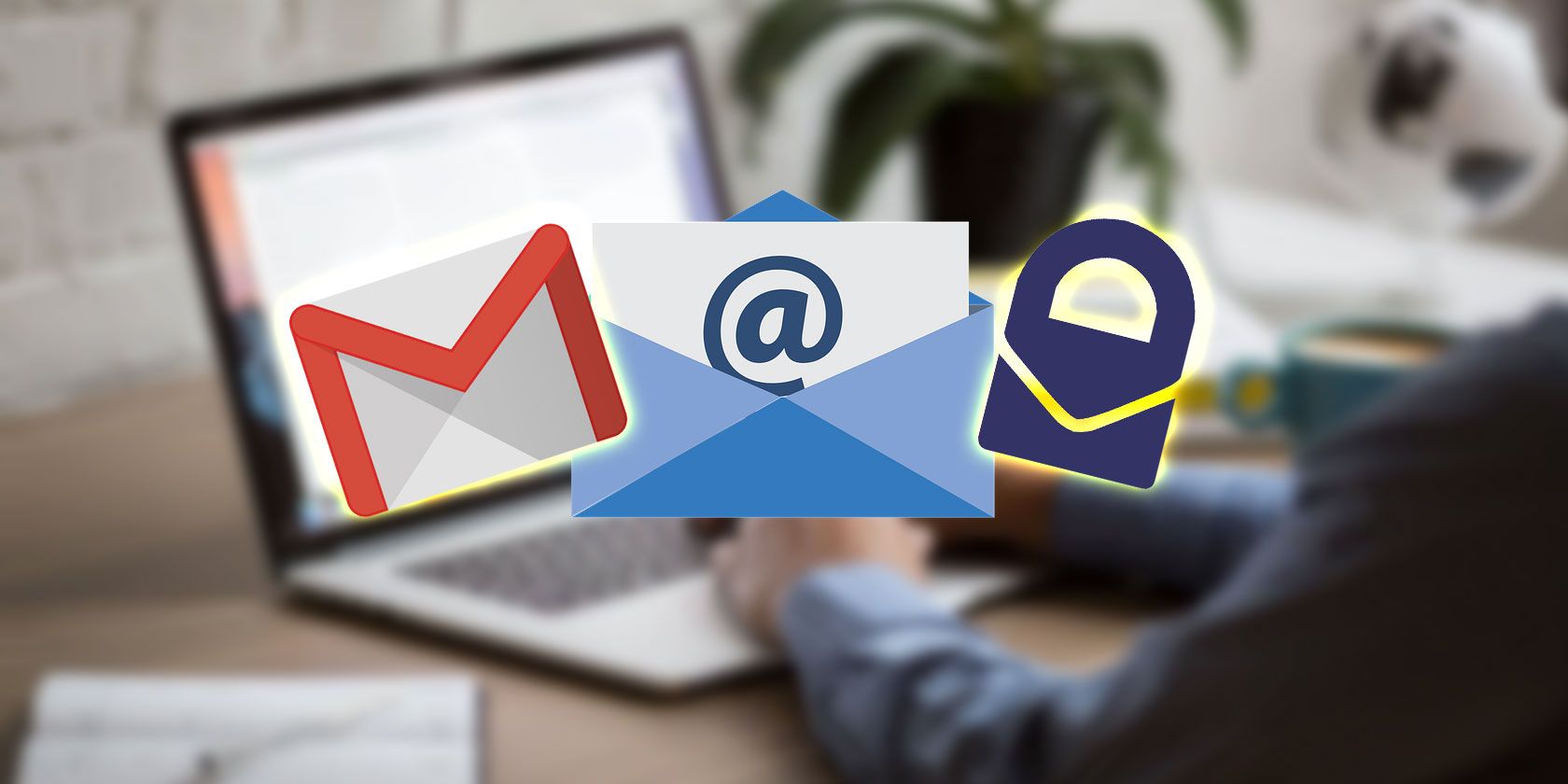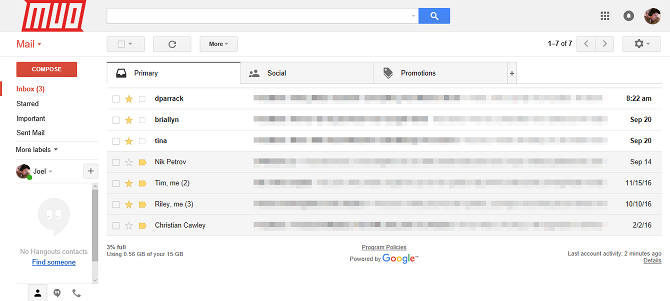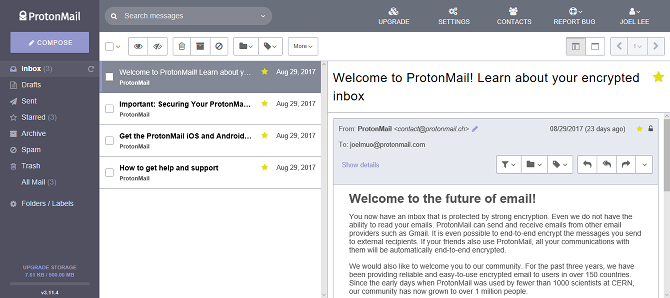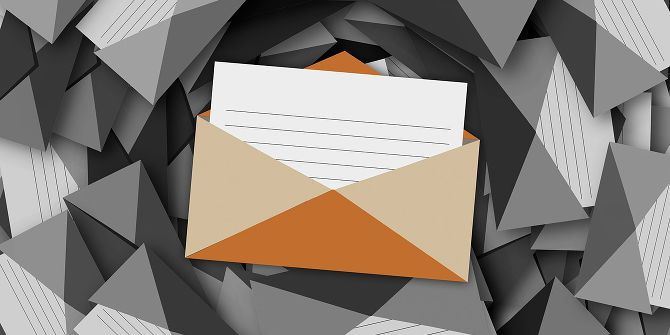Of all the best free email services out there, Gmail and ProtonMail sit at the top: one for convenience, one for privacy. ProtonMail is the most secure free email service right now, and we recommend it for anyone fearful of data breaches.
But is ProtonMail right for you? The answer isn't easy.
As awesome as ProtonMail is on paper, it does have a few drawbacks that may make it unusable for your specific needs. Here's our full comparison of Gmail vs. ProtonMail to help you decide if switching over is the right move.
Interface
Gmail
Gmail has had the same general interface since its debut in 2004, although obviously with tweaks here and there. Your email navigation is done in the sidebar, your inbox is filtered into tabs (which you can customize), and emails are managed through a toolbar along the top.
Unlike most modern email clients, Gmail's interface uses a two-page design. You have the full inbox view (first page), then you click into individual emails (second page), then return to the inbox view. To me, this isn't the most efficient way to browse through many emails.
But overall, the Gmail interface is great. The simplicity and minimalism are non-distracting, and it's both fast and responsive.
ProtonMail
ProtonMail's interface is more like what you'd expect from modern email clients: a three-pane approach with main navigation on the left, an inbox view in the middle, and currently-selected email view on the right.
Like Gmail, ProtonMail adheres to a clean and minimal approach in its design. Every interface element has a purpose, and no space is wasted. But unlike Gmail, ProtonMail isn't afraid to use boxes to separate different areas, and this makes it feel more organized and easier to navigate.
Either way, you can't go wrong: Gmail and ProtonMail both have the upper hand against pretty much all other free email services.
Privacy
Gmail
Gmail supports a kind of encryption called point-to-point encryption (P2Pe). With point-to-point encryption, your emails can be read by you and by Google but nobody else.
Here's an analogy: Google provides you with a lockable pneumatic container. You write a letter, stick the letter inside the container, lock the container, then send it through a pneumatic tube directly to Google. Google can then unlock the container, pull out your letter, and do whatever it wants with it.
P2Pe is good because it prevents third parties from snooping -- even if somebody intercepts your letter, they wouldn't be able to unlock it. But Google can still read your emails.
There are benefits to this. Google needs access to emails to determine if it's spam, to let you to quickly search emails, and to make sure your emails are never lost (which can happen if the email is encrypted and you lose your key). But as far as privacy goes? Google does read your emails.
ProtonMail
In addition to P2Pe, ProtonMail supports a deeper kind of encryption called end-to-end encryption (E2Ee). With end-to-end encryption, your emails can't be read by anyone except yourself.
Here's a modified analogy: ProtonMail provides you with a lockable pneumatic container. But after you write your letter, you encode it with a cipher before locking it in the container, then send it off. ProtonMail can unlock the container just like Google, but it can't read the letter without your cipher.
This is why ProtonMail provides a "Login Password" (for P2Pe) and a "Mailbox Password" (E2Ee). ProtonMail stores your login password but NOT your mailbox password. If you lose your mailbox password, you will lose ALL of your emails.
In short, ProtonMail is infinitely more private than Gmail, but also a great deal riskier. If you're prone to lose passwords, or if you have emails that you absolutely cannot lose, then ProtonMail may not be worth the risk.
This also means that ProtonMail does NOT support IMAP, POP3, or SMTP. As of this writing, the mailbox password feature requires web browser technology, so you can only access ProtonMail on the web.
Pricing
Gmail
Gmail's pricing scheme: FREE with all features and 15GB of space.
- In order to curb spammers, Gmail limits you to 500 recipients per email and a maximum of 500 outgoing emails per day. If you reach this limit, it will reset within the next 24 hours.
If you regularly send emails in bulk to the same addresses, one workaround is to create a Google Group with those contacts, then send your emails to the Group's address. This will count as one outgoing email.
ProtonMail
ProtonMail's pricing scheme is a bit more complicated.
- Free accounts get 1 email address, 500MB of storage, up to 150 outgoing messages per day, up to 3 folders/labels for organization, and none of the advanced features: email filters, autoresponder, catch-all email, or multi-user support.
- Plus accounts are €5/mo ($6/mo) and get 5 email addresses, 5GB of storage, up to 1,000 outgoing messages per day, up to 200 folders/labels for organization, and two of the advanced features: email filters and autoresponder. Most users probably need this tier for personal email.
If you can get by with the free tier, then great! But if you have an extremely tight budget with no room for paid email, then ProtonMail may not be a viable option.
Migrating From Gmail to ProtonMail
As expected, the main difference between Gmail and ProtonMail is privacy -- and privacy does come at a cost. In an ideal world, we wouldn't have to make such a choice. But we do.
If you decide that ProtonMail is right for you, note that the migration pipeline is NOT yet complete. As of this writing, you can import contacts but not messages.
Export Gmail Contacts
- At the top left, switch from Mail view to Contacts view.
- In the top toolbar, click More > Export...
- Choose All contacts and Outlook CSV format, then click Export.
- If necessary, pick a location for the CSV file download.
Import Contacts to ProtonMail
- In the top toolbar, click Contacts.
- At the top right, click Upload.
- Click in the area labeled "Drop Here," navigate and select your CSV or VCF contacts file, then click Upload.
Note that ProtonMail can only import CSV or VCF files that are formatted in UTF-8. This means you may have trouble importing contacts recorded in other languages, including Arabic, Asian, and Cyrillic.
Export Gmail Messages
- Go to Google's Data Download page.
- Click Select None, scroll down and enable Mail, then click Next.
- Choose ZIP as the file type, 2GB as the archive size, and Send download link via email as the delivery method.
- Click Create archive.
ProtonMail's Import Messages feature is still being developed, but it's still a good idea to back up your messages now so you can have them on hand when the feature is ready. Who knows if Google will disallow this in the future?
Forward Gmail to ProtonMail
Setting up email forwarding is a convenience option. Gmail's forwarding does NOT use end-to-end encryption, but messages WILL be point-to-point encrypted (so you don't have to worry about them being intercepted).
- In Gmail, click Gear icon > Settings.
- Navigate to the Forwarding and POP/IMAP tab.
- Click Add a forwarding address at the top.
- Enter your ProtonMail address, then click Next.
- Wait for Gmail's confirmation email to arrive in your ProtonMail inbox, then click the verification link in that email to authorize the forwarding.
- Refresh Gmail, navigate back to the Forwarding and POP/IMAP tab if necessary, then select Forward a copy of incoming mail at the top. Choose your ProtonMail address, as well as "Keep Gmail's copy in the Inbox."
- Scroll down and click Save Changes.
How Important Is Email Privacy to You?
If you want to cut ties with Gmail and Google altogether, see our article on clearing all your Google data. If you can't afford ProtonMail and will reluctantly be using Gmail, see our article on improving your Gmail security.
Regardless of which email service you use, it's important to always practice good email security habits.
Are you willing to pay for email privacy? Or does it not bother you that Google (and other email services) can read your emails? Let us know in the comments!





